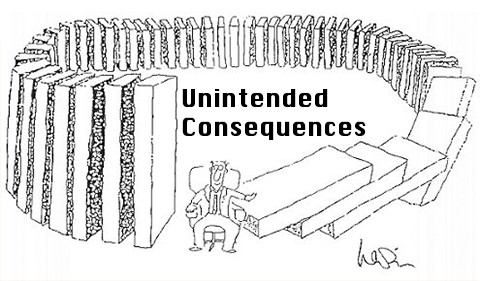Synergetics: Physical principles and basics
Synergetics – sounds a bit esoteric and some (scientists) would probably give a meta-theory of order and change no more credibility than esotericism. And yet, synergetics – based on physics – promises precisely such a theory! But how does physics have anything to do with us humans and our behaviour? A quick answer is simple – all of us consist of nothing else than star dust ;).
The more comprehensive answer lies in synergetics.

Synergetics is the most developed interdisciplinary science explaining the formation and self-organization of patterns and structures. It was originally founded by the physicist Hermann Haken. Synergetics is a meta-theory of transformation and innovation processes, whose basics principles can be applied to physical, biological, psychological, as well as social and organisational processes. In order to accomplish that, the theory is based on physics and mathematical formalisations on an abstract level[1: p.31].
Without getting too mathematical (!), this first episode of synergetics will delineate the most important principals, ideas and terms of synergetics for those readers, who have an interest in natural sciences, or at least are curious how we relate to star dust. I promise I will do my best to describe these basics in the most accessible way I can. If you, however, would like to skip this episode and immediately want to continue with the next one – what synergetics has to do with transformation and organisational change – you are welcome to do so.
For those of you, who decided to stay – welcome to the world where I connect the natural sciences with the social sciences :).
Open & complex systems
Self-organization always takes place within a certain system. We humans, for example, are bio-psychological-social systems and an organisation is a social system[1]. Systems are concrete or abstract objects, which
- have definite boundaries, and yet are open to their surroundings (e.g. an organisation)
- consist of individual parts (e.g. employees)[1: p.77]
Within a system these individual parts may interact with each other under certain conditions (e.g. with respect to norms & rules, organisational culture or shared goals) and may interact with the outside of the system under certain other conditions. The boundaries of this system can be described by the so-called boundary conditions. For example, a vase is a system which hinders liquid to flow outside.
Synergetics is concerned with so-called open & complex systems. Open means that the system’s boundaries are characterised by rules on how an interaction is possible with the outside of the system. These rules are also part of the boundary conditions. Plausible examples are the in-/out flow of energy into a biological system or the provision and remuneration of services of organisations. Complex refers to the system consisting of a plurality of individual parts, which can interact with each other in various ways. Because of the system’s complexity, these dynamics are generally non-linear, which means that a small change in the process may have a huge impact in the outcome (more on chaos theory below). The consequence of non-linearity is that the predictability of a certain outcome given a certain input is relatively low. That is also the simple reason why top-down directed measures often have unintended consequences.

The system’s determining factors
Essentially, there are 3 sorts of factors, which determine any system:
- Control parameters:
The boundary conditions, which describe the boundaries between system and environment, are represented by so-called control parameters[1: p.247]. These describe the influence of the surroundings on the respective system. Examples are external circumstances, such as the magnitude of the energy influx, the stock price, the economic situation or the size of the organisation. Control parameters are the relatively most difficult influenceable factors of the system. - Order parameters:
These are the predominant/ leading parts of the system. Examples are dominant figures, the purpose of the organisation, the organisational culture or its structure. Order parameters embody macroscopic qualities that emerge from microscopic qualities of the system (more on emergence below). The organisational culture, for example, can’t be “installed” externally by some consultant just like that; instead it is the result of the interaction between employees, which, in turn, originates from their values and those of the organisation1. Order parameters can be more easily influenced than control parameter. However, they are relatively more stable than the so-called enslaved parts of the system.
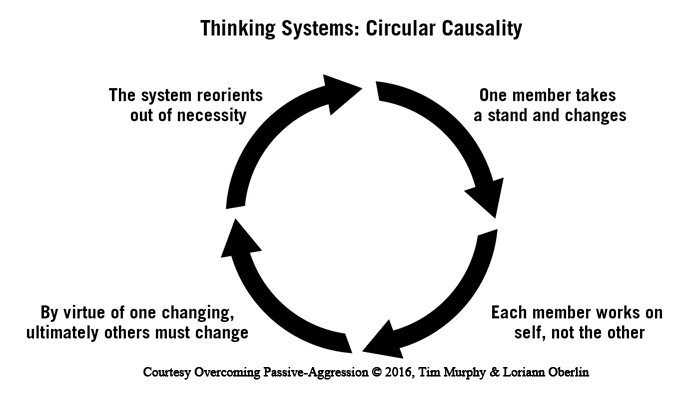
Source
- Enslaved parts:
While order parameters emerge from the interaction of the parts of the system, order parameters, in turn, enslave the system’s parts (principle of enslavement). Hence, we are dealing with a so-called circular causality. Examples of circular are positive/ negative feedback loops. “Enslavement” may sound quite brutal, but has a different connotation in physics (macroscopic properties of a system influencing microscopic ones) and shouldn’t be taking literally.
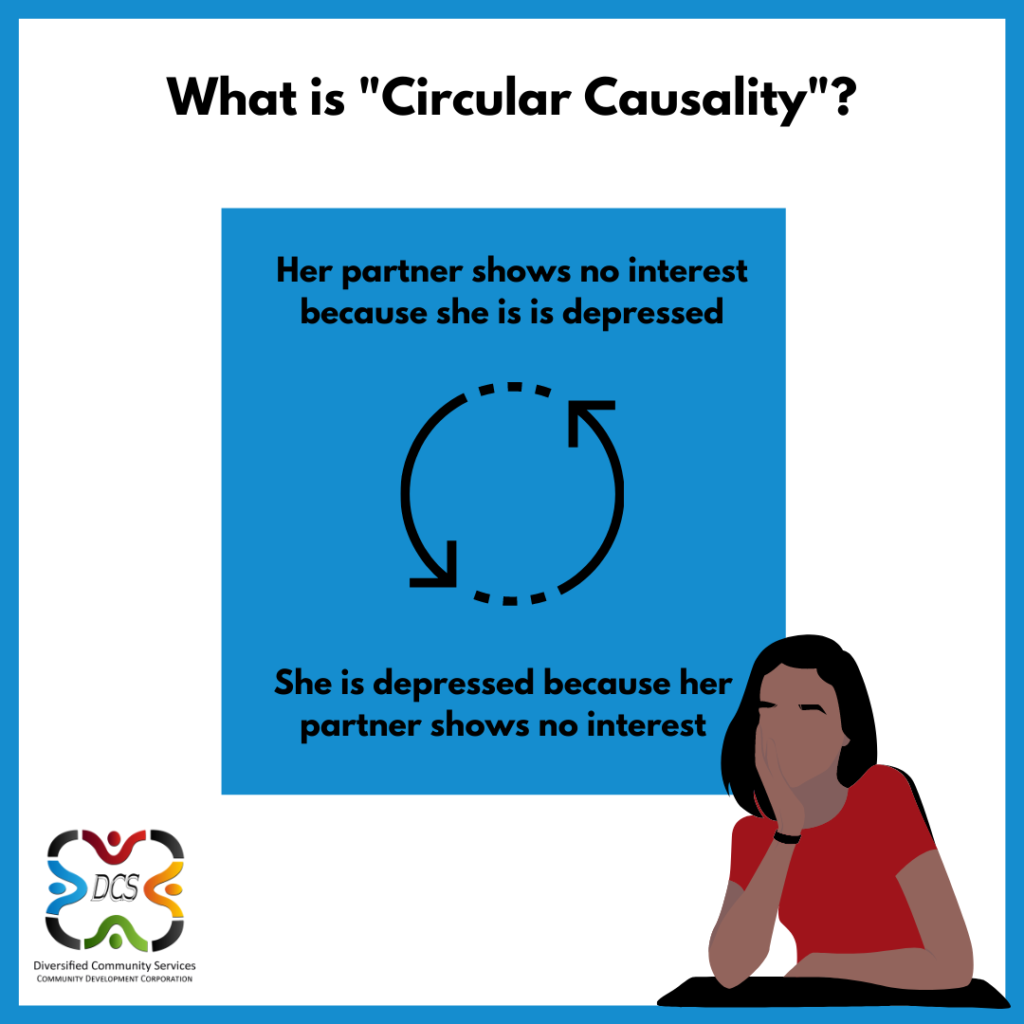
Often we have the choice of whether we’d like to be “tag-alongs” or whether we choose to act, for example, against organisational norms. Nevertheless, we should not underestimate the implicit and subtle impact of order parameters, such as an organisational culture or behavioural norms in our society, especially because deviant behaviour often causes us to suffer negative consequences. In this sense, we could say we are enslaved to institutional norms (we do have the conscious choice to act against them, however in most cases that is not worth the trouble). The enslaved parts of the system are the relatively most dynamic (most influenceable) factors of the system.
The model of self-organisation
Self-organization within a system can therefore be illustrated by Fig. 1:
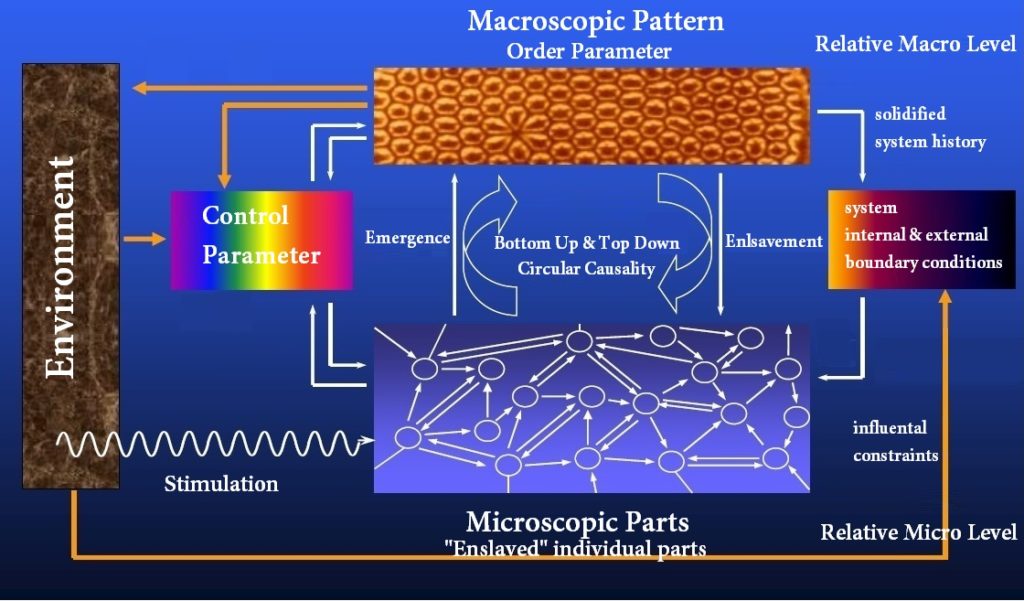
Source: Originally from a presentation by Arne Wunderlin (1990), adapted by [1] and translated from German by me
The order parameters are “located” on the system’s relative macro level, while the enslaved parts can be found on the relative micro level. The definition of micro- and macro level depends on what sort of system we are looking at. Considering a water surface, for instance, a wave would be a phenomenon on macro level, while the individual interacting water drops would take the role as the enslaved parts on the micro level. Water drops themselves are macro phenomena as compared to the relative micro phenomena of H2O molecules (and others) interacting with each other. With respect to an organisation, we could consider the organisational culture as an order parameter on the macro level, while the behaviour of the individual employees would be described through the micro level. In a social system like our society, we can easily depict institutional norms as macro phenomena, which prescribe certain behaviour to us humans on the micro level.
“Micro- and macro level are relative to each other. This means that what in one system is an order parameter/ located on the macro level, could be an individual part of a new self-organised system on the next higher level. In human systems nested systems play a big role (e.g. neuronal networks in the brain or functional units in organisations).”
– [1: p.135; translated from German]
Emergence
As mentioned above, macroscopic phenomena (macro level) emerge out of the dynamics of the individual parts of the system (micro level). Emergence refers to the “development of novel properties (or qualities) of a system”[1: p.79], which cannot simply be explained solely based on the properties of the individual parts that make up the system. We need to clarify two terms at this point; what does “novel properties” and “cannot simply be explained” actually mean in relation to emergence?
What is regarded as “novel properties” (just like the definition of micro- and macro level) depends on the point of view. For example, considering the human brain, consciousness would be a “new” phenomenon, arising from the chemical interactions of the biological neuronal network. Taking an organisation as an example, the organisational culture would be a “novel” phenomenon, emerging from the interactions of many humans (bio-psychological-social systems, including consciousness). “Cannot simply be explained” is also a relative statement: Most phenomena are only at first glance not reductively (i.e. based on the sum of its individual parts) explainable. Looking more carefully, one can find out which properties of the individual parts, paired with influences from the environment, lead to the dynamics, which eventually spawns the macro phenomenon. Often this requires means of scientific methods and technological innovations or at least a certain level of knowledge. For example, chemical compounds can be fully explained by means of physics (chemical compounds are macro phenomena relative to the physical properties they consist of). If a phenomenon can – at least theoretically – be explained reductively, we are dealing with the so-called weak emergence. We may also call it quasi emergence, since the emergent character of the macro phenomenon disappears, when one takes a closer (educated) look at the properties and interactions of the micro parts of the system.
Strong emergence, thus genuine emergence, brings true chance into the game. What is true chance?
In order to illustrate the difference between true and actually explainable chance, I give an example that emerged from a private communication with Dr. Helmut Schöller, scientist at the Institute for synergetics and psychotherapy research in Salzburg (Austria): In daily language we would call it an unfortunate co-incidence if somebody who tiles their roof, drops a tile at exactly the moment a runner passes by. In daily language it makes sense to draw this back to chance, because those two bio-psychological-social systems (roofer & runner) are not in an obvious relation to each other. In this case, this means that they didn’t agree with each other on this event and the roofer didn’t have a motive to drop the tile. And yet, this unfortunate event is a deterministic process, which means that it can be theoretically fully explained on basis of all relevant circumstances (the timing, the location, the reason for accidental dropping etc). The state of affairs is different when quantum fluctuations join the game – these are by definition indeterministic, i.e. “real random” coincidences.
We do not yet quite know at our current state of research, which phenomena are strongly or weakly emergent. When phenomena seem to be strongly emergent, it could be that more research leads to an explanation of the dynamics of the individual parts and therefore the phenomenon in question is actually weakly emergent. This is why for a scientist it is highly recommendable to assume weak emergence (and ontological reductionism2), otherwise one would forgo any possibility to explain up front.
“The outer influences as well as the interactions of the parts with each other can be truly deterministic, but they can also be pure coincidence. The question of the nature of randomness is […] of fundamental philosophical importance: Is a random event genuinely not explainable by deterministic processes or does it just seem random, because of our lack of knowledge about the underlying actually deterministic processes? The majority of physicists2 reckon: both kinds of coincidences exist, whereby true randomness is based in quantum mechanics.
– [1: p.77; translated from German]
Why do we talk about weak emergence if it is not in fact “real” emergence? The term is very useful, because – whether weak or strong – emergence emphasises the phenomenal, factually novel and different character of systematic and macroscopic properties as compared to the properties of the individual parts. Synergetics delivers an explanation of how we can draw explanations on the abstract macro-phenomenological level without full knowledge or inclusion of the micro level[1: p.135], which is what we already do in science and in daily life anyways. For example, we can describe an organisational culture, without having to refer to the individual behaviour of the employees, which contribute to the culture and are influenced by it (emergence- and enslavement principle).
A hierarchy of interacting self-organised systems
To summarise the model of self-organisation (Fig. 1): The individual parts of a system interact with each other and the environment (micro level). The control parameters describe the conditions for these interactions. Phenomena (macro level) emerge from these complex and non-linear interactions, introducing novel qualities (emergence principle), which, in turn, influence the individual parts (enslavement principle). Therefore, we are dealing with circular causality: phenomena on the micro level cause phenomena on the macro level, which in turn influence the micro level, and so forth. The question where the initial start was is probably a chicken-and-egg problem. Macro-and micro level are relative to each other, depending on the respective system, and yield dynamics which influence other systems and the environment:
“The system’s order parameter dynamic can become the control parameter of another system and the other way round […] A self-organised system is part of a whole hierarchy of other systems, whereby the system’s macroscopic dynamics become the micro processes of another system, and so forth. This applies to neuronal, psychological as well as to interpersonal processes.”
– [1: p.246; translated from German]
You may remember the Coleman Boat from the last episode of the decision making series, which illustrated the emergence of social phenomena from the interaction of human beings? In essence, this figure was just a simpler illustration of the model of self-organization (Fig. 1). Is it now obvious why I stated in that episode, that rational choice theory is an application of synergetics for the emergence of social phenomena?
Chaos or order? Chaos AND order!
Last but not least, chaos theory comes into the picture of synergetics. Contrary to how we use the term chaos in our daily lives, chaos in physics does not denote complete disorder, but actually requires some state of order!
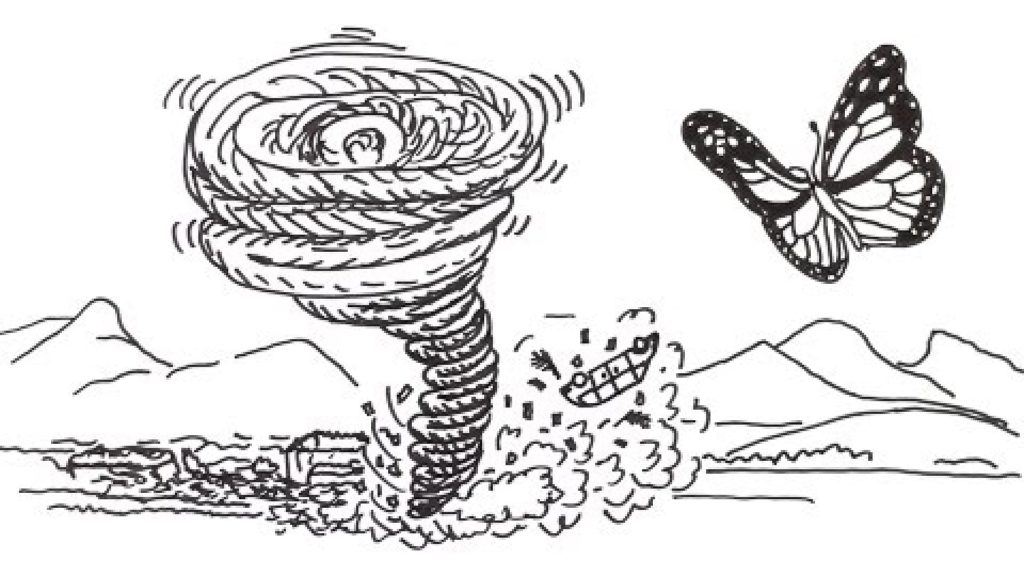
“Chaos is a self-organising process”, which results from the interaction of a plurality of different elements[1: p.304]. Chaos theory is commonly known as the “butterfly effect”; a stroke of a butterfly’s wing may cause a tornado on the other side of the globe. This illustration emphasises one of the most important characteristics of chaos: a minor change in the root cause (wing flap), may lead to a major impact (tornado). Therefore, we observe a non-linear relationship between input and output.
Contrary to our linear understanding of causality of our mechanistic image of the world – a certain input causes certain output – a property of chaos is that the output is not that easily predictable. Chaotic processes are only contingently predictable, because small deviations in a process may lead to large differences in the further course of events. Contrary to our intuition, however, chaotic processes are generally deterministic, which means that they are – at least theoretically – fully explainable. Except, of course, quantum mechanical randomness is at play. Chaos arises from the non-linear interactions happening in complex systems. Not only the weather, but also our brains, social interactions and organisations are all examples of such “chaotic” systems.
One could say that self-organisation is chaotic order.
Therefore, synergetics is able to model complex systems by means of chaos theory.
Synergetics: The Meta-Theory of Self-Organisation
Self-organisation is “characterised by coherent pattern formation, spontaneous order transitions, internal dynamics and the emergence of novel qualities”[1: p.64]. Self-organisation doesn’t only happen within physical phenomena, such as water waves or planetary motions, but also within learning and development processes of humans and social structures. Synergetics can explain how macroscopic phenomena of all sorts emerge out of microscopic ones and how they can impact them in turn. Synergetics does so by means of chaos theory and its key principles (control parameter, order parameter, enslaved parts and circular causality). The key achievement of synergetics is its ability to explain and model the dynamics of highly complex phenomena, based on these few principles. Therefore, synergetics is a meta-theory for self-organisation and transition processes.
Synergetics, thus, delivers scientific explanations for change and transformation processes. The next episode of the synergetics series digs into what transformation means in terms of synergetics. How one can make use of the self-organising potentials of a complex system, I will describe in the episode after next.
1 Remember, that in this episode of human decision making we learnt that human behaviour is based on an actor’s own values and the system’s values (so-called institutional norms) in which they navigate. Institutional norms are therefore order parameters.
2 As a natural scientist I believe in ontological reductionism, which means that the whole of reality consists of a minimal number of different parts (strings? quarks?) and physical laws of interaction that make up all that exists (through emergence). I believe that, at least in theory, everything must be explainable on this basis. (Of course, in most cases it’s not necessary or practical to break down everything into the micro level of atoms and quarks.) The only way I see “real unexplainable” dynamics factoring in is by means of quantum mechanics, which could lead to true chance. I have had many discussions with social scientists, who do not believe in ontological reductionism. Until today, I think one who doesn’t believe in reductionism, believes in magic. After all, if you do not think that a certain phenomenon can be at least theoretically explained, you believe in something unexplainable like magic. This is also why many physicists are uncomfortable with quantum mechanics, because it’s the closest scientific theory to magic there is. I have also experienced some social scientists dramatizing the role of quantum mechanics, to put a scientific label on their belief in magic. Beware, if one brings quantum fluctuations into the game, one must also be able to explain, why and how they are able to “surface” (i.e. influence) macro-phenomena. Which is what we will do in the next episode.
References [1] Haken, H. & Schiepek, G. (2006, [2010]): “Synergetik in der Psychologie – Selbstorganisation verstehen und gestalten”, Hogrefe; Quotes are translated from German by me
Navigate through the episodes of the special theme The Science of Human Behaviour here:
Table of Contents
- Introduction to The Science of Human Behaviour
- Motivation: Research shows that there are 5 different types of motivation. Especially the aggregate forms – autonomous vs. controlled motivation – have a different impact on our well-being.
- Decision Making: Rational Choice Theory explains how we make our 35000 daily decisions and how social phenomena arise from our individual behaviour.
- Episode 1: From situation to action
- Episode 1.1: Institutional Norms
- Episode 2: Taking action
- Episode 2.1: Excursion: Deviant Behaviour
- Episode 3: Emergence of Social Phenomena
- Self-Organisation & Transformation: Synergetics – the meta-theory of order transitions – connects the natural sciences with the social sciences and explain what we can change and what we cannot.
- Synergetics-Dictionary
- Episode 1: Physical principles and basics
- Episode 2: The relevance of transformation
- Episode 3: The Agile Organisation
- Episode 3.1: The Synergetic Navigation System (SNS)
Written by Julia Heuritsch | Last edited: 3rd October 2022
This article was originally written for the blog of the unternehmensdemokraten.
